Ethnic California: Parallel Histories and Alternative Voices
Guide
This exhibit, located in the conference room of the Department of Chicano Studies, will take you through several significant, yet also painful eras in California’s ethnic history. It will inform, it may perhaps provoke some new thinking, and hopefully, cause some reflection. Students who have been assigned study questions about the exhibit can find a list of questions here.
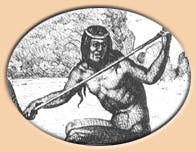 The first display case is devoted to a visual survey of the local Chumash civilization, their long history and flourishing civilization, their subjugation, their 1824 revolt, and finally, the decimation of this noble people.
The first display case is devoted to a visual survey of the local Chumash civilization, their long history and flourishing civilization, their subjugation, their 1824 revolt, and finally, the decimation of this noble people.
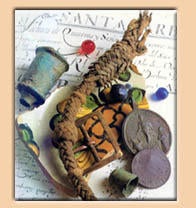 The wall exhibit cases begin with a discussion of the ethnic composition of the early settlements and a reconstruction of daily life in Spanish and Mexican California. A display case is dedicated to an examination of the Treaty of Guadalupe Hidalgo, a historic document that transferred half of Mexico to the United States. Voices of protest that were raised during this tumultuous period are recorded here.
The wall exhibit cases begin with a discussion of the ethnic composition of the early settlements and a reconstruction of daily life in Spanish and Mexican California. A display case is dedicated to an examination of the Treaty of Guadalupe Hidalgo, a historic document that transferred half of Mexico to the United States. Voices of protest that were raised during this tumultuous period are recorded here.
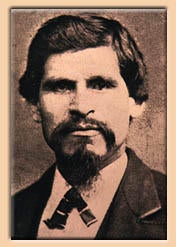 The next flat case leads one to experience the less well-known, but seamier side of the Gold Rush Era. The Foreign Miners Tax of 1851 and its disruptive social impact on people of color in this state is presented. The Californio hero bandits, such as Tiburcio Vasquez and Joaquin Murieta are discussed. The display includes an 1850 revolver that is said to have belonged to the legendary Murieta. The contributions of the Black miners and cowboys are highlighted. So is the rampant vigilantism that marked this period, which led to infamous incidents such as the Downieville lynching in 1851 of the beautiful and pregnant young Mexican woman known as Juanita (or Josefa) that is depicted in this display case.
The next flat case leads one to experience the less well-known, but seamier side of the Gold Rush Era. The Foreign Miners Tax of 1851 and its disruptive social impact on people of color in this state is presented. The Californio hero bandits, such as Tiburcio Vasquez and Joaquin Murieta are discussed. The display includes an 1850 revolver that is said to have belonged to the legendary Murieta. The contributions of the Black miners and cowboys are highlighted. So is the rampant vigilantism that marked this period, which led to infamous incidents such as the Downieville lynching in 1851 of the beautiful and pregnant young Mexican woman known as Juanita (or Josefa) that is depicted in this display case.
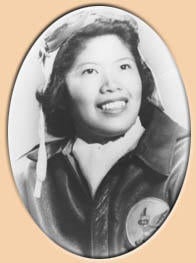 The display on the World War II era celebrates the role of Chinese American women in wartime, such as Maggie Gee, a flier with the Women’s Airforce Service Pilots, and the riveter Nancy Lew Mar. Viewers also learn of Executive Order 9066, directed against people of Japanese ancestry. Photographs and personal accounts present the harsh life of 110,000 Japanese Americans in the internment camps. Viewers learn, too, of the Servicemen Riots, also known as the "Zoot Suit Riots," that occurred in this period. Through journalistic accounts of the day, one is led to ponder how similar events might very well happen in any historical era.
The display on the World War II era celebrates the role of Chinese American women in wartime, such as Maggie Gee, a flier with the Women’s Airforce Service Pilots, and the riveter Nancy Lew Mar. Viewers also learn of Executive Order 9066, directed against people of Japanese ancestry. Photographs and personal accounts present the harsh life of 110,000 Japanese Americans in the internment camps. Viewers learn, too, of the Servicemen Riots, also known as the "Zoot Suit Riots," that occurred in this period. Through journalistic accounts of the day, one is led to ponder how similar events might very well happen in any historical era.
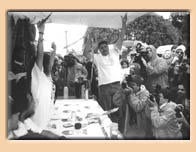 The exhibit culminates with the voices of contemporary protests, including the 1965 Watts Riots, the 1969 Chicano Moratorium against the Vietnam War, the 1969-71 American Indian Movement take-over of Alcatraz Island, the Black students’ takeover of the UCSB Computer Center in 1968, and finally, the achievements of the UCSB Hunger Strikers of 1989 and 1994.
The exhibit culminates with the voices of contemporary protests, including the 1965 Watts Riots, the 1969 Chicano Moratorium against the Vietnam War, the 1969-71 American Indian Movement take-over of Alcatraz Island, the Black students’ takeover of the UCSB Computer Center in 1968, and finally, the achievements of the UCSB Hunger Strikers of 1989 and 1994.
Historical Eras:
Pre-1850
Gold Rush Period
World War II
Contemporary Protest Movements
The exhibit is co-sponsored by the Asian American Studies, Black Studies, and Chicano Studies Departments. Faculty consultant for the exhibit is Xiaojian Zhao, Asian American Studies.
All graphic images on this webpage are copyrighted
and should not be reproduced without permission.
Text author: Salvador Güereña. Page maintained by: CEMA.
Page designed by Todd Chatman. Last modified: April 24, 1999.


